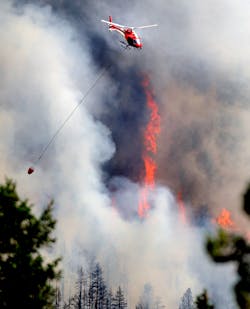Waldo Canyon Fire Probe Moves From Field to Lab
The long days spent sifting through the Waldo Canyon fire's ashes for clues to its origin have largely passed.
Now, most of the investigative work will be in a lab.
The move from field to lab signals the next phase into the investigation of the cause of the state's most destructive fire, said Steve Segin, spokesman for the Rocky Mountain Area Coordination Center.
Investigators have revealed little information about the investigation into the blaze, which sent smoke billowing into the sky on June 23 and blackened 18,247 acres. Most of the destruction came in the fire's first four days, when flames raced out of Queens Canyon and into Colorado Springs, destroying 346 houses and killing two people.
An eight-agency team found the spot where the fire started about a week and a half after the fire was reported.
Barb Timock, spokeswoman for the U.S. Forest Service, declined to comment on the type of tests being conducted, as well as where the samples are being tested -- citing the fact that the investigation remains open and active.
The move to laboratory work doesn't necessarily mean the investigation is nearing an end, said Steve Steensland, a retired U.S. Forest Service investigator who owns a private fire investigation firm.
In fact, it could take months.
"I hate to use this trite analogy, but it ain't CSI where the end of the day -- 45-mintues of program time -- you got an answer," said Steensland, who has investigated fires for more than 30 years. "You don't feed evidence in this magic machine and it spits out the name, date of birth and street address of who was responsible for the fire."
Laboratory includes such work as conducting metallurgical sampling and painstakingly sifting through dry ashes -- such as when lab technicians looked for paper embers in the ashes of the 2002 Hayman fire.
After the Hayman fire, Terry Barton, a former U.S. Forest Service employee, pleaded guilty to starting the 138,000-acre blaze when she said a love letter she ignited caught the surrounding forest on fire. She served six years in prison and was ordered to pay $44.5 million dollars for the fire.
The problem: Lab technicians found no evidence of paper where the fire started, Steensland said.
The discovery -- or lack of evidence, in this case -- raised further questions, a common occurrence during lab testing.
To cut down on the likelihood the paper drifted away in the wind or rain, Steensland later burned paper in his backyard and let the fire ring sit for six weeks. Meanwhile, he blasted the area with fans and watched as two storms dropped at least a quarter-inch of rain on his test site.
A month and a half later, Steensland said he still spotted paper with his bare eyes -- leading him to doubt Barton's account.
Barton pleaded guilty before he could testify on his results, Steensland said.
Other lab tests are done to determine if accelerants were used to start a blaze. Steensland said such tests often yield few results during wildfire investigations, because he's found flammables such as gasoline are rarely used. Usually, there's enough dry fuels to start a forest fire.
The key, Steensland said, is patience.
"It's not uncommon for these cases with the lab testing to go on months, months and months after the fire," Steensland said. "It may lead you to a new piece of evidence, which then is subjected to further testing."
Copyright 2012 - The Gazette, Colorado Springs, Colo.
McClatchy-Tribune News Service
